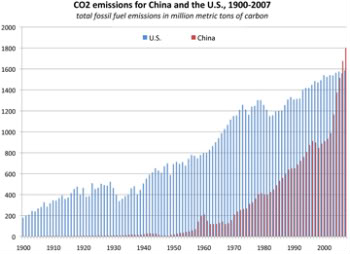|
|
In a move that many have seen as a step forward for China in terms of its willingness to combat climate change, the nation’s top climatologists have released a report recommending that China begin drawing down greenhouse gas emissions after 2030. The report comes just four months before a widely anticipated global meeting to set up a new international framework to combat climate change in Copenhagen, Denmark.
The year, 2030, is the first mention of a target date for capping greenhouse gasses by China, a remarkable departure from China’s long unwillingness to set greenhouse gas targets. However, the report is meant to advise the government in China and does not signal any direct policy decisions.
 Solar powered yurt in China. Photo by: Rhett A. Butler. |
The 900 page report, entitled the “2050 China Energy and C02 Emissions Report” proposes that the growth of greenhouse gas emissions should begin slowing by 2020 and should be capped off at 2030. By 2050, the report predicts that China could lower its emissions levels to those of 2005 or earlier.
“This report is intended to advise the government what its options are,” Deborah Seligsohn, China Program Director with the World Resources Institute, told Reuters “I think they’re making a pretty concentrated push to move the negotiations forward.”
 CO2 Emissions for the United States and China frmo 1900 to 2007. |
In 2008, China became the world’s largest emitter of greenhouse gases, ahead of long-time leader the United States. However, China’s output of greenhouse gases is still much lower than the U.S. per capita.
The report notes that China could face many disasters from climate change if effective action is not taken, including longer droughts, worse storms, threats to water supplies, and lower agricultural yields.
If China is in fact moving forward on a plan to tackle greenhouse gas emissions, it is likely that this will increase the focus and pressure on the United States during the meeting in Copenhagen. The U.S., which is not a signatory of the Kyoto treaty, has long stood against tough treaties on climate change, largely arguing that developing countries like China and India should do more. Yet now, with movement from China and a new administration in Washington expectations may be high for the United States to finally move aggressively against global warming.
Related articles
US responsible for 29 percent of greenhouse gas emissions over past 150 years
(05/31/2009) In the past 150 years, the United States has emitted more greenhouse gas emissions than any other nation in the world, according to a recent report by Greenpeace. In fact, US emissions account for 29 percent of the world’s total since the mid-1800s. The US emitted 328,264 million metric tons of carbon dioxide (MtCO2) in the past 150 years, which is over 3 times the amount emitted by China in the same century-and-a-half.
China’s emissions rise 45%, but Western demand accounts for 30% of increase
(02/26/2009) Thirteen-and-a-half percent of China’s 45 percent rise in greenhouse gas emissions between 2002 and 2005 can be attributed to export production for Western countries, reports a new study published in Geophysical Research Letters. In other words, outsourcing of manufacturing by American and European firms accounted for larger share of carbon dioxide emission growth than rising domestic consumption in China (which made of 7 percent of the figure). The results, which indicate that Western companies are effectively outsourcing emissions along with manufacturing, have implications for future climate treaties, says one of the authors.
CO2 emissions accelerate 400% as world turns to dirtier fuels
(09/26/2008) Atmospheric carbon dioxide levels rose at a record clip in 2007, according to the Global Carbon Project’s annual overview of the greenhouse gas.